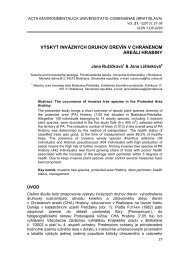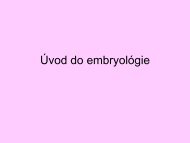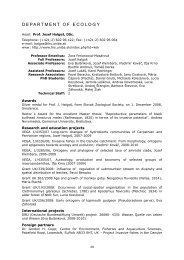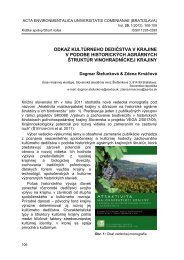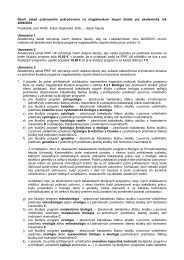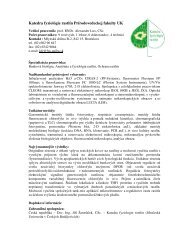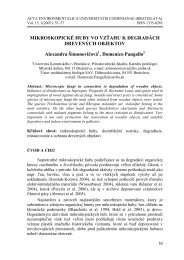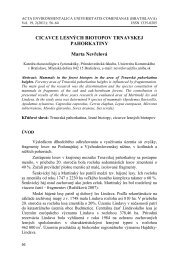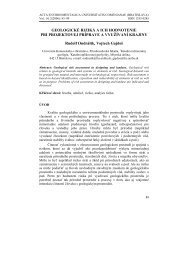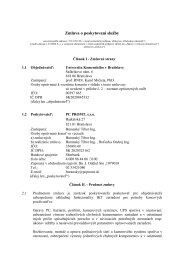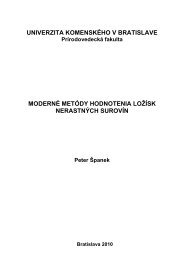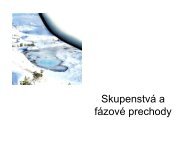UNIVERZITA KOMENSKÉHO V BRATISLAVE VZÁCNOPRVKOVÁ ...
UNIVERZITA KOMENSKÉHO V BRATISLAVE VZÁCNOPRVKOVÁ ...
UNIVERZITA KOMENSKÉHO V BRATISLAVE VZÁCNOPRVKOVÁ ...
You also want an ePaper? Increase the reach of your titles
YUMPU automatically turns print PDFs into web optimized ePapers that Google loves.
fractionation level. Ferrotantalite compositions with Ta/(Ta+Nb) = 0.63-0.72 and<br />
Mn/(Mn+Fe) = 0.20-0.27, which penetrate the empirically defined natural tapiolitetapiolite<br />
miscibility gap, belong to striking feature of the Duchonka leucogranite. Despite<br />
lack of XRD determination, the phase very likely belongs to ferrotantalite, and not<br />
ferrotapiolite. These anomalous compositions form external parts of columbite-tantalite<br />
crystals and they represent a part of the same columbite to tantalite evolutional trend with<br />
rapid Ta/Nb increasing and stable Mn/Fe ratio. On the contrary, ferrotapiolite occurs as<br />
separate grains with different textural pattern and chemistry. Such tantalite or tapiolite<br />
compositions are exceptional and they are considered as metastable. On the other hand, an<br />
empirically determined field of the tantalite-tapiolite miscibility gap is based only on<br />
known data from granitic pegmatites. However, the Duchonka pegmatitic leucogranite<br />
had to crystallize at higher temperature compared to classical granitic pegmatites. For that<br />
reason, the tantalite-tapiolite miscibility gap has most probably smaller range at such<br />
conditions.<br />
Nb-Ta-W mineral assemblage was found in the highly fractionated leucogranite at<br />
Dlhá dolina, near Gemerská Poloma. The studied rock can be characterized as highly<br />
evolved, specialized S-type topaz-albite granite enriched in Li, B and F with greisenized<br />
and albitized parts. It consists mainly of albite, quartz, muscovite and zinnwaldite.<br />
Common accessory minerals include topaz, cassiterite, turmaline, rutile, wolframite,<br />
apatite and Nb-Ta-W phases. Besides the most widespread manganocolumbite, rarely<br />
ferrocolumbite, W-rich ixiolite, pyrochlore, microlite and uranmicrolite were identified.<br />
Ferrocolumbite forms discrete crystals up to 30 µm in size, usually enclosed in<br />
albite or quartz, in association with cassiterite, rarely also microlite. The chemical<br />
composition is relatively constant, with Ta/(Ta+Nb) = 0.12–0.16 and Mn/(Mn+Fe) =<br />
0.32–0.46. Ferrocolumbite reveals elevated content of W (up to 7.2 wt.% WO3).<br />
Manganocolumbite forms discrete irregular crystals up to 200 µm in size, in<br />
association with cassiterite, rutile or apatite. The chemical composition is relatively<br />
heterogeneous with Ta/(Ta+Nb) = 0.06–0.50 and Mn/(Mn+Fe) = 0.50–0.95.<br />
Manganocolumbite is often replaced by microlite. They have developed progressive<br />
zoning with central parts enriched in Nb and outer parts enriched in Ta. Simultaneously,<br />
decrease in Mn/(Mn+Fe ratio was detected with increase of Ta/(Ta+Nb) ratio in outer<br />
parts of manganocolumbite crystals. Manganocolumbite exhibit elevated content of W (up<br />
to 10 wt.% WO3) and Ti (up to 3.8 wt.% TiO2).<br />
134



